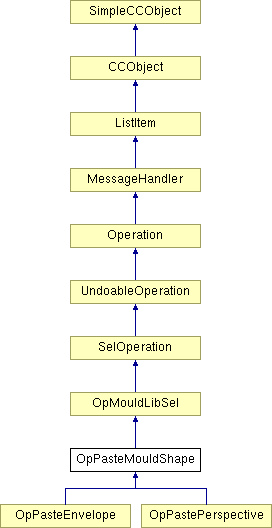
#include <moldtool.h>
Inheritance diagram for OpPasteMouldShape:

Public Member Functions | |
| OpPasteMouldShape () | |
| Constructor for paste mould shape operation. | |
Protected Member Functions | |
| void | Do (MouldSpace mSpace) |
| Take the contents of the clipboard and try to use whatever shape exists there as a mould shape. The mould space type is passed to this function as a parameter. The function will find the first renderable object on the clipboard, try to make shapes of it and use the first shape returned as the mould space object. | |
Static Protected Member Functions | |
| static BOOL | FindPasteObject (Node **pReturnNode) |
| This function scans for objects on the clipboard. It tries to find the first object which Is a NodeRenderableInk Can become a nodepath If there is such an object the function will return true, and set the return pointer to point at the object if the return pointer exists ie is a none null receptor. | |
Definition at line 394 of file moldtool.h.
|
|
Constructor for paste mould shape operation.
Definition at line 1981 of file moldtool.cpp.
|
|
|
Take the contents of the clipboard and try to use whatever shape exists there as a mould shape. The mould space type is passed to this function as a parameter. The function will find the first renderable object on the clipboard, try to make shapes of it and use the first shape returned as the mould space object.
Definition at line 2053 of file moldtool.cpp. 02054 { 02055 BeginSlowJob(); 02056 02057 Node* pPasteNode; 02058 BOOL Constrain=KeyPress::IsConstrainPressed(); 02059 02060 // Obtain the current selections 02061 SelRange* Selected = GetApplication()->FindSelection(); 02062 if (!Selected) 02063 { 02064 FailAndExecute(); End(); return; 02065 } 02066 02067 // is there a suitable object on the clipboard? 02068 if (!FindPasteObject(&pPasteNode)) 02069 { 02070 FailAndExecute(); End(); return; 02071 } 02072 02073 // HERE 02074 02075 // If so lets force the object to become a nodepath 02076 // Do this none undoably because we are doing things on the clipboard. 02077 // If we DoBecomeA passback on a perspectivised filled object, it hides 02078 // the original? 02079 MouldBecomeA ParamBecomeA( BECOMEA_PASSBACK, 02080 CC_RUNTIME_CLASS(NodePath), 02081 NULL); 02082 02083 // Get pNode to generate its paths for us 02084 BOOL ok = pPasteNode->DoBecomeA(&ParamBecomeA); 02085 // whip the resulting mould path out of the do becomea param class 02086 NodePath* pNodePath = ParamBecomeA.GetMouldPath(); 02087 if ((!ok) || pNodePath==NULL) 02088 { 02089 FailAndExecute(); End(); return; 02090 } 02091 02092 // remember the selection before the operation 02093 if (!DoStartSelOp(TRUE,TRUE)) 02094 { 02095 FailAndExecute(); End(); return; 02096 } 02097 02098 ObjChangeFlags cFlags; 02099 cFlags.DeleteNode = TRUE; 02100 ObjChangeParam ObjChange(OBJCHANGE_STARTING,cFlags,NULL,this); 02101 02102 if (!Selected->AllowOp(&ObjChange)) 02103 { 02104 ERROR3("AllowOp() returned FALSE, i.e. op should have been greyed out"); 02105 FailAndExecute(); End(); return; 02106 } 02107 02108 // Trash the selection bounds 02109 Range Rnge = (*Selected); 02110 if (!DoInvalidateNodesRegions(Rnge,TRUE,TRUE)) 02111 { 02112 FailAndExecute(); End(); return; 02113 } 02114 02115 // Calculate the destination paste position 02116 DocRect Bounds = Selected->GetBoundingRect(); 02117 DocRect sBounds = pNodePath->GetBoundingRect(); 02118 02119 Node* pNode = Selected->FindFirst(); 02120 if (pNode==NULL) 02121 { 02122 FailAndExecute(); End(); return; 02123 } 02124 02125 if (!Constrain) 02126 { 02127 // If we're not constraining, then we might have to force constrain 02128 // on to ensure the object pastes within the bounds of the spread. 02129 // We'll try to expand the pasteboard, and if that fails, we'll 02130 // turn constrain on 02131 02132 // find the spread of the destination selected node (fix to Jason bug) 02133 Spread *pSpread = pNode->FindParentSpread(); 02134 if (pSpread == NULL || !pSpread->ExpandPasteboardToInclude(sBounds)) 02135 Constrain=TRUE; 02136 } 02137 02138 if (Constrain) 02139 { 02140 // if 'control' constrain is pressed then paste the mould 02141 // shape centred over the selection otherwise leave it where 02142 // it is. 02143 INT32 tx = (Bounds.lo.x+Bounds.hi.x)/2 - (sBounds.lo.x+sBounds.hi.x)/2; 02144 INT32 ty = (Bounds.lo.y+Bounds.hi.y)/2 - (sBounds.lo.y+sBounds.hi.y)/2; 02145 Trans2DMatrix trans(tx,ty); 02146 pNodePath->Transform(trans); 02147 } 02148 02149 // Grab the ink path from its node 02150 Path* pShape = &(pNodePath->InkPath); 02151 02152 // using this list create or replace the mould bits 02153 ok = DoCreateOrReplaceMould(Selected, pShape, mSpace, TRUE, FALSE); 02154 if (!ok) 02155 FailAndExecute(); 02156 02157 // Update all the changed nodes, i.e. tell all the parents of the children that have been effected 02158 ObjChange.Define (OBJCHANGE_FINISHED,cFlags,NULL,this); 02159 UpdateChangedNodes(&ObjChange); 02160 02161 End(); 02162 }
|
|
|
This function scans for objects on the clipboard. It tries to find the first object which Is a NodeRenderableInk Can become a nodepath If there is such an object the function will return true, and set the return pointer to point at the object if the return pointer exists ie is a none null receptor.
Definition at line 2008 of file moldtool.cpp. 02009 { 02010 BOOL found=FALSE; 02011 02012 // find the first object 02013 Node* pNode = InternalClipboard::GetInsertionLayer()->FindFirstChild(); 02014 while (pNode && !found) 02015 { 02016 // ok lets check what we've got here 02017 BecomeA TestBecomeAPath(BECOMEA_TEST, CC_RUNTIME_CLASS(NodePath)); 02018 if ((pNode->IsKindOf(CC_RUNTIME_CLASS(NodeRenderableInk))) && 02019 (pNode->CanBecomeA(&TestBecomeAPath)) 02020 ) 02021 found=TRUE; 02022 else 02023 pNode=pNode->FindNext(); 02024 } 02025 02026 if (found && pReturnNode) 02027 *pReturnNode=pNode; 02028 02029 return found; 02030 }
|
 1.4.4
1.4.4